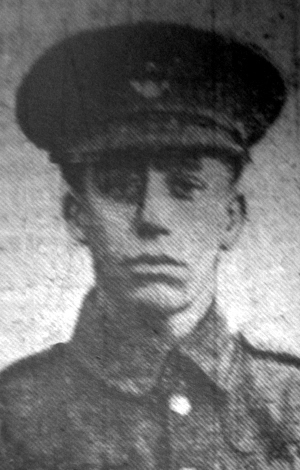
Alfred Bilbrough was born in Ossett on the 14th July 1895 and baptised at South Ossett Christ Church on the 19th December 1897. Alfred’s sister, Gladys, born 5th November 1897, was baptised on the same day. Alfred was the son of John and Eliza (nee Roberts) who married at Dewsbury All Saints Church on the 25th December 1883.
In 1895, John was a carrier and lived at Healey, Ossett. In 1901, John Bilbrough, a carter and farmer, born in Smeaton, is still living at Healey, Ossett with his wife, Eliza, and six children: four girls and two boys, aged between 5 months and 13 years.
In 1911, John and Eliza have been married for 27 years and have had ten children, all born in Ossett, and all have survived to 1911. Alfred is now aged 15 and is working as a colliery labourer. They are all living in a three-roomed house at Gas Work’s Row, Healey. In addition, they have a lodger, who is a carter like John Bilbrough. Eliza Bilbrough is now aged 50 and the children in the household are aged between one and twenty-five years of age: three of the children, one son and two daughters in the Bilbrough household are aged one. The two eldest girls are aged 23 and 21 and it is likely that the youngest children were theirs.
The 1st/4th Battalion of KOYLI was formed in August 1914 at Wakefield as part of the 3rd West Riding Brigade, West Riding Division. The battalion moved on mobilisation to Doncaster and then in November 1914 to Gainsborough. They moved on to York in February 1915 and on the 12th of April 1915 landed at Boulogne in France. On the 15th of May 1915 the formation became 148th Brigade, 49th (West Riding) Division.
Alfred Bilbrough was killed in action on the 13th of April 1918, aged 22 years, son of Mrs. Eliza Bilbrough of 31, The Green, Ossett, in the defence of the village of Neuve Eglise in Flanders, Belgium.
On Friday the 12th of April 1918, the Germans had got over the Lys at Merville and had reached to outskirts of the Forest of Nieppe in front of the town of Hazebrouk, however a fierce resistance put up by the British 31st division had denied both the forest and the town to the enemy. During that day the Germans had also begun a new thrust towards Mount Kemmel in the south of the Ypres Sector. The greatest weight had been thrown at the defences in front of Neuve Eglise.
Before WW1, Neuve Eglise (now called Nieuwkerke), was an insignificant Belgian village to the north of Armentieres, on the road leading to the town of Kemmel. In April 1918, at this crucial stage of the war on the Western Front, the village had been defended by elements of the 148th (3rd West Riding) Brigade of the Territorial 49th (West Riding) Division, consisting of the 1st/4th Battalion of the King’s Own Yorkshire Light Infantry and the 1st/4th (Hallamshire) Battalion of the York and Lancaster Regiment, in company with the 2nd Worcesters, the Brigade, in trenches to the north of the village, had been under constant enemy artillery bombardment and enemy infantry harassment throughout the eleventh of April and early the next day the Germans had launched a concentrated infantry attack which had succeeded in forcing an entry into the southern part of the village.
Ejected from their positions by this assault, during the early hours of the following day, Saturday the 13th of April, the West Yorkshiremen together with the Worcesters, had mounted a counter attack ‘with great spirit’, which after a ferocious bout of street fighting, had managed to drive the enemy out of the village and back some 150 yards or more, the K.O.Y.L.I. capturing seventeen German infantrymen in the village Y.M.C.A. in the process.1

Above: Fighting at the village of Neuve Eglise (now Nieuwkerke) in April 1918.
Alfred Bilbrough’s army service record has not survived. His medal card states that he was posthumously awarded the Victory and British medals. His KOYLI regimental numbers were 4890 and 202114. The 1914-15 Star was not awarded and he was killed in action the 13th April 1918.
Perhaps Alfred’s death in April 1918 was too much for his father, John, to bear and shortly afterwards he too died leaving a widow, Eliza, who had also lost her son. The Bilbrough family were probably typical of many a family in the Great War in that they lost more than one soldier. Alfred’s second cousin, Percy Bilbrough of Grenoside, Sheffield, was killed in action on 3rd May 1917 at Bullecourt serving with the 2/5th KOYLI and a third cousin, Lt Stephen Mark Crabtree of 12th battalion East Yorkshire (Hull Sportsmen) was also killed in action on the Somme on 28 Jun 1916 whilst preparing for the 31st (Pals) Division attack on the village of Serre, near beaumont Hamel.
Private Alfred Bilbrough is remembered on Panel 108-111 on the Tyne Cot Memorial 2, West-Vlaanderen, Belgium. The Tyne Cot Memorial to the Missing forms the north-eastern boundary of Tyne Cot Cemetery, which is located 9 kilometres north east of Ieper town centre, on the Tynecotstraat, a road leading from the Zonnebeekseweg (N332).
The Tyne Cot Memorial is one of four memorials to the missing in Belgian Flanders which cover the area known as the Ypres Salient. Broadly speaking, the Salient stretched from Langemarck in the north to the northern edge in Ploegsteert Wood in the south, but it varied in area and shape throughout the war. The Tyne Cot Memorial now bears the names of almost 35,000 officers and men whose graves are not known.
References: